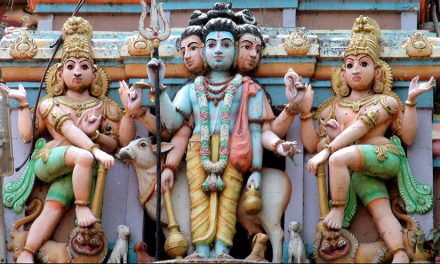“Jai Jagannath Swami Nayan Pathagami Bhabatume”
Duryodhan, the crest jewel of the Kaurava race, along with his younger brothers and warriors like Bhisma, Drona, Karna and others, breathed his last in the great Mahabharata war. On the other hand, the Pandavas and their wife Draupadi started for their eternal journey to the heavenly planets. In order to end the mal-administration, growing lack of discipline and anarchy of the past days and to re-establish religious truth, Lord Sri Krishna, the King of Dwaraka, destroyed His own race. Later, Sri Krishna was struck by the poisonous arrow of hunter Jara Savar. During this critical juncture, the royal throne of Indraprastha remained vacant. Taking all these incidents as the base material, the epic Mahabharata was written, following the conversation between Agasti and King Manu.
The grandson of mighty Arjuna, righteous Pariksit, adorned the royal throne of Indraprastha. As a great literary creation of his time, Srimad Bhagavatam was composed adopting the conversations between Shukadev and King Pariksit. Later, the Bhagavad-gita was written, incorporating the 575 cantos (slokas) of Sri Krishna’s instructions to Arjuna at the beginning of the Kurukshetra war, 84 of Arjuna, 40 of Sanjaya, one from Dhrutarastra. The grand total of these cantos comes to 700. Throughout all these voluminous literary creations, however, there is no trace of the essence of Lord Purusottama.
Since time immemorial, the dwelling house of the Supreme Lord of the Universe, Sri Jagannath, is accepted as a holy place of India. To this day, Jagannath Puri is glittering with pure Orissan culture and heritage. According to Orissan historians, the magnitude of Lord Jagannath first bloomed as a tribal deity and later on as the object of Buddhist, Jain and Vaisnava worship. Although in the past Sri Jagannath has been described as Buddhist and Jain, in fact, the great Jagannath culture is not influenced by any sectarian principle in any age, rather Lord Jagannath has influenced many sects throughout the world.
The greatness of Daru Bramha has become lively in the text, Sarala Mahabharata. Once being enraged, king Hiranya questioned his minor son Prahlad about the existence of the Supreme Lord. Prahlad indicated a pillar of the palace as his answer. Hearing the bold answer of Prahlad, Hiranyakashipu, with much cruelty and wrath, hit the pillar by his sword. Immediately, Lord Nrsimhadev emerged out of the pillar in the Form of a half-man, half-lion being, and mitigated the sorrows of Prahlad. According to the great Oriya poet, Sharala das:
Are Jala Analu Tarilu Narayananku Dhyaee
Mote Kahakina Tora Narayan Achhi Kahin
Re Re Kara Karina Uthila Bira Nade
Se Thambena Praharila Neye Bama Pade
Hiranya Bidarina Ananta Jagannath
Prahallada Kai Chirayusha Dianta Se Natha
(Sarala Mahabharata – Bhisma Parva)
“Lord Nrsimhadev is regarded as the fourth incarnation of Lord Vishnu. In the invocation to his Mahabharata, Sharala das has described Lord Nrsimhadev as Shi Jagannath. Both Lord Sri Rama Chandra and Lord Sri Krishna Chandra are also named as Kodandadhari and Dandadhari. Thus, it indicates the relation of these Lords with Daru.”
In the Musali Parva of Oriya Mahabharata, it has been described that the hunter Jara scored an arrow to Lord Sri Krishna and the Lord breathed his last and merged with Lord Vishnu. Later, Jara and Arjuna, while starting to perform the cremation of Lord Sri Krishna, heard a heavenly voice, “set fire to My mortal remains using the log on which you find the symbols conch, wheel, club and lotus.”
As per the Lord’s direction, Arjuna placed the body of Lord Sri Krishna on sandal wood and set fire to it. But the Pinda (heart) did not burn. During this event, Jara mistakenly thought that Lord Sri Krishna had earned sins during His lifetime and thus, the fire was unable to turn His body to ashes. According to Sarala das:
Puni Bicharai Ye Rabana Maila
Bala Kalare Je Rohini Badha Kala
Gogosthe Pasina Sandhasura Mari
Balatkare Harila Gouraba Gopastiree
Jabante Se Dosa badha na kala aba
Paraloke Ani Lagaila Badha
“While Jara was thinking deeply, again the Heavenly voice resounded, This heart will not be gutted in fire. Immerse the body in the sea, it will be worshipped on the Neelasundar hill.”
After a lapse of long years, a Daru was seen floating in the sea. King Indradyumna and Savar Biswabasu brought the Daru to the shore, as per the order of the Lord. After installation of the Deities inside the temple, Sri Jagannath expressed His extreme happiness and ordered King Indradyumna for soliciting boon, as per his desire.
According to the poet Sri Krishna das in Deulatola:
Tumbhe Jebe Baradeba Maguacchi Muhin
Mohara Bansare Kehi Nathibe Gosain
Putra Nati Bolibe Je Deula Ambhara
Ambhara Bolante Dharma Jiba Je Mohara
‘Such type of sacrifice is indeed rare. The Gods did not understand the mystery behind this sacrifice. This symbolises the greatest ideal of Sri Jagannath Consciousness.’
Sri Jagannath Culture represents a voice of spiritual equality. Being inspired by Sri Jagannath Consciousness, Goddess Laxmi made her kind presence in the cottage of a low caste woman, for which she was insulted and scandalised. But at last, victory of equality was accepted by all. In the voice of Goddess Laxmi:
Muhin Chandaluni Jebe Teki Debi Anna
Bhojana Karibe Tebe Kaliya Ganjana
“This was the forceful promise of Goddess Laxmi, who being inspired by Sri Jagannath Consciousness, glorified the pride of both Lord Sri Jagannath and Sri Balabhadra.”
In conclusion, it can be said that the Sri Jagannath Cult is rich in its own style and not influenced by any other sectarian principle, rather it has influenced other sects and delivered the message of equality, peace, salvation and harmonious feelings for the well being of the entire human civilisation.











